
|
|
| home | contact | team t&d | group websites | markets | exports | blog |
 |
|
Going Green - Tips for Making Your Truck More Environmentally Friendly
By Chris Dodds on 4th December, 2014
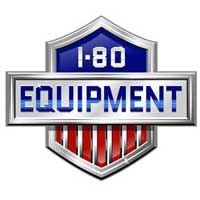
T&D are delighted to have been given the opportunity to publish the following Guest Blog by Linda Snell. Linda is Marketing Director at I-80 Equipment, the world's largest bucket truck dealer. I-80 supply bucket trucks to utilities in all 50 US states plus Canada and Mexico.
I-80 are the number one source for fully reconditioned used bucket trucks and utility trucks at used-equipment prices. I-80 inventory includes used bucket trucks, digger derrick trucks, boom trucks, forestry trucks, grapple trucks, dump and sewer trucks and specialty equipment for the electrical, telecommunications, forestry, tree service and utility industries.
Sit back and let Linda waltz you through this post.....
"As winter approaches, you want to make sure your truck is in top shape and ready for the cold months ahead! Part of that involves proper diesel management, which can prevent you from ever being stranded. I-80 Equipment is here to help you maintain its condition. Here are a few tips to conserve your diesel, and more importantly, “Go Green”.
- Charge the air cooler - A loss of boost pressure can significantly affect the air: diesel ratio, causing an inefficient burn. As a result, the operator sees reduced power and poor economy.
- Check the air filter - This is something the driver/operator should do daily. A product like FilterMinder is one of the easiest indicators out there, and it helps efficiently monitor your filter.
- Replace Injectors in Sets - When one cylinder fails, it could indicate an issue with the remaining ones. Replacing the cylinders as a set ensures maximum performance.
- Maintain Proper Road Speed - How fast you drive is probably the easiest way to net the best rate of return. According to Caterpillar, you give up 0.1 MPG for every mile over 55. Also, be sure to check your tires.
- Check the Tire Pressure - Proper inflation goes hand in hand with diesel consumption. The preferred inflation specs are printed on the side of the tire, as well as in the owner’s manual. Rolling resistance also plays a major role in diesel economy, higher resistance and lower economy.
- Monitor the Wheel Alignment - Aligning all of the axles is always better than a front axle alignment. A solid alignment ensures proper tire life, and thus diesel economy. The suggested interval is at 12,500 miles, then every 60,000 miles or when new tires are installed.
Pictured : Altec AT40M-2011 Dodge Ram 5500 4×4 Bucket Truck
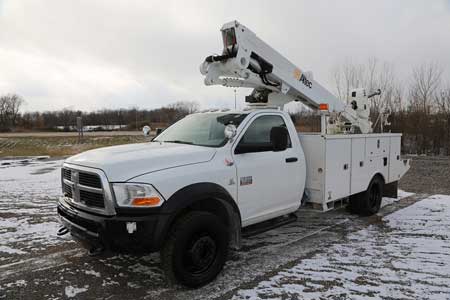
As a driver, you can monitor your output while on the job and the road. Remember these tips to improve efficiency:
- Enroll in a diesel bonus program, which rewards drivers for proper conservation.
- Reduce “warm-up” time to equal “walk around” inspection time.
- Use Progressive Shift Technique, which allows you to change gears as early as possible when accelerating. As a result, you stay within your torque range.
- Use Cruise Control to maintain a consistent speed and save diesel
- Do not drive with the engine fan on.
- Try to lug your engine in the 1100-1200 range
- Reduce idle time
Pictured: 1999 Bombardier GT2000 HYNT All Terrain Track Digger Derrick
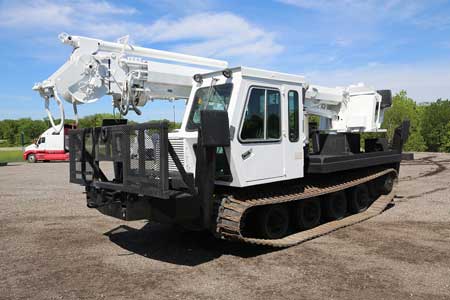
Bucket and diesel truck operators should heed the following tips to reduce their carbon footprint:
- Reduce unnecessary idling by using auxiliary power units and electric units. Be sure to enforce idling limits.
- Use Verified Diesel Emission Control Technology (VDEC), verified Diesel Particulate Filters (DPFs) or Diesel Oxidation Catalysts (DOCs).
- Fill the truck with cleaner-burning substances like Ultra-Low Sulfur Diesel (ULDS), biodiesel, liquid petroleum or compressed natural gas.
- Replace older engines with newer, cleaner ones that are more energy-efficient.
Pictured: 2004 Vermeer V120 Trencher - Backhoe
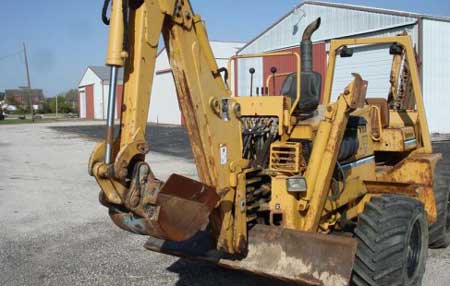
In addition, consider engine upgrades and conversion kits that lower air emissions and diesel consumption. A new vehicle or vessel provides the driver and company with reliability, warranty benefits, lower maintenance costs and increased diesel efficiency. If environmental safety is what you desire, look into an alternative diesel vehicle .
Also, retrofit devices can reduce diesel particulate by up to 85%. These devices use a catalytic process and/or filter technology to reduce carbon monoxide, hydrocarbon emissions and Diesel Particulate Matter (DPM).
Pictured: MAXON Lift Gate-2004 International 4300 4×2 Box Truck
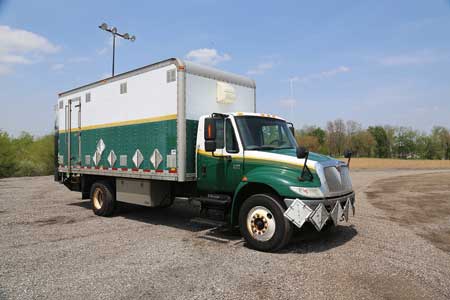
Anti-idling retrofits reduce emissions and diesel using the following:
- Thermal storage systems
- Diesel-operated systems
- Auxiliary power units or generators
- Automatic shutdown/startup devices
- Shore power plugs
- Truck stop electrification
Pictured: VAC-CON V230-2005 International 7400 4x2 Sewer Truck
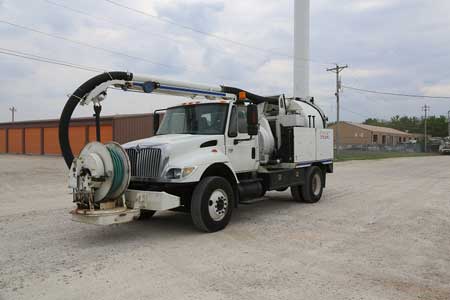
For fleet drivers or operators, reducing diesel consumption and greenhouse emissions is critical. Train drivers and operators on diesel-efficient driving strategies (also known as green driver training), and create rewards programs that offer incentives for conserving diesel.
Preventive maintenance programs are crucial to increasing vehicle life and efficiency, reducing downtime, cutting costs, and improving overall fleet safety.
Pictured: Vactor 2112 HXX-2004 International 7600 6x4 Hydro-Excavator
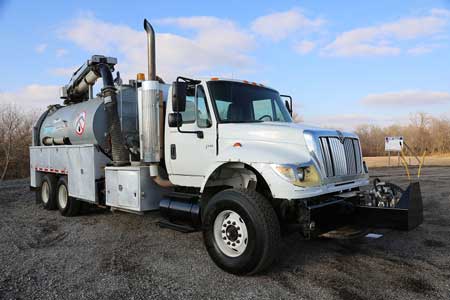
Below are a few tips to help increase the diesel efficiency in fleet trucks that can help them stay on the road longer.
- Upgrade to a high-flow exhaust system and high-flow air filter - “If the motor can’t breathe, it won’t be efficient.” Turndown kits cost less than $200 and mufflers run under $100. He does not suggest changing the exhaust manifold or the catalytic converter unless it is absolutely necessary since labor and parts are expensive. If a truck is not running efficiently, a visual inspection for damage or wear of the exhaust system can help determine why. If performance is sluggish, even after a tune-up, check the exhaust system for weak pipes and rust. Some high-flow replacement filters come with a 1-million-mile warranty and maintain airflow even when dirty.
- Monitor your spark plugs - Change spark plugs at 60,000 miles if you have iridium or platinum plugs, and every year or 7,000 miles for copper plugs. Regardless, check them yearly. Discolored spark plugs can indicate that the motor is running rich or lean. If it is running rich, the truck is probably using too much diesel, and if lean, there is not enough diesel. In this case, the O2 sensor might need to be checked. Jarantilla recommends changing the O2 sensors about every 80,000 miles.
- Buy the right tires and check tire pressure often - Tires can affect mileage by up to 10%, so it is important to maintain proper tire pressure and to check it often. Proper tire pressure optimizes diesel efficiency and tire wear, and monitoring pressure helps operators catch air leaks while they are small. Avoid the temptation to buy bigger tires, which look great but reduce diesel economy
- Add helper springs - A maxed out suspension will put undue pressure on tires, especially over bumps. Bulging tires wear out faster and create more friction. This makes the truck work harder and causes it to burn more diesel. Installing auxiliary metal springs or air springs gives the operator more leeway in terms of payload capacity, and air springs can be adjusted to accommodate the truck’s load.
- Firm up the shifts and check the gear ratio - The less time spent shifting means more time the diesel is used to move the truck instead of shifting gears. For a firmer shift and to increase transmission durability, install a shift kit. If necessary, the transmission shop can also change the truck’s rear axle gear ratio to one more appropriate for the weight loaded onto the truck and how it is driven (city or highway).
- Eliminate unneeded aftermarket accessories - Assess whether any large accessories are necessary, as the added weight does make a difference in diesel economy. Bully bars and headache racks look good, but if that is all they do, take them off. Front air dams should be left on, as they improve aerodynamics. Also, keep aerodynamics in mind when loading a truck, especially when driving on the highway. Keep loads to the center of the vehicle and behind the cab so items do not catch the wind.
- Upgrade the electrical grounds - A quick and easy preventive maintenance modification for older vehicles is to upgrade the grounds, which helps ensure all the electrical sensors such as 02 sensors and mass airflow sensors communicate accurately with the truck’s computer system.
- Consider a diesel injection cleaner - Try high-quality diesel along with a diesel injection cleaner, which is designed to help keep intake valves clean and lubricate the upper cylinders to aid in maintaining efficiency. Diesel consumption is affected by what the vehicle carries and the weight of the cargo. Total weight is the critical factor, and this often changes during the journey, as cargo is picked up and dropped off. Every additional axle increases weight and diesel consumption. Strategic loading decisions improve efficiency, for example, weight distribution. If a driver organizes cargo correctly, the engine works less, and thus conserves diesel.
- Check Air Pressure - Underinflated tires can decrease diesel economy significantly. Studies have shown that 10-percent under inflation could result in at least a 6-percent loss in diesel economy. You should check the tire pressure when a tire is “cold” - before the driver starts the vehicle ignition or drives less than one mile.
- Valve Caps - As a rule of thumb, valve caps should be installed on all valve stems and kept tight. Metal valve caps are best, as they contain a rubber gasket to provide an airtight seal. Most plastic caps do not contain a rubber gasket.
- Improved Routing Adds Up to Diesel Cost Savings - Routing is another way fleets manage diesel expenses. Routes, traffic, and road conditions are all important factors to consider in calculating diesel consumption. Slow routes through hilly terrain decrease diesel economy in even the most efficient vehicles. A busy urban environment also impacts diesel consumption due to the amount of stopping and starting. Teaching drivers to plan their runs and map out their trips is not only diesel-efficient, but time-efficient as well.
Video: I-80 Bucket Trucks Overview
Category: HV Cable Jointing & Terminating
Sort by Category:
- #ThrowBackThursday
- 3M Scotch Tapes
- ABB Power Products
- Business
- Cable Accessories
- Cable Cleats & Cable Ties
- Cable Containment LV HV
- Cable Crimping & Cutting Tools
- Cable Jointer Training Courses
- Cable Jointing - PhotoBlog
- Cable Labelling & Marking
- Cable Laying & Cable Pulling
- Cable Transits & Duct Sealing
- Company Updates
- Earthing & Lightning Protection
- Electrical Equipment HV
- Electrical Equipment LV
- Electrical Safety & Arc Flash
- Exports
- Flexible Conduit Cable Management
- Hazardous Area Electricals & Lighting
- HV Cable Jointing & Terminating
- LV Cable Jointing & Terminating
- Nexans Euromold Cable Accessories
- Plugs & Sockets
- Power Distribution & Feeder Pillars
- Prysmian FP Cables
- PV Solar Farms
- Rail
- T&D History Blog
- Terms & Conditions of Sale & Purchase
Tweets by @ThorneanDerrick




























